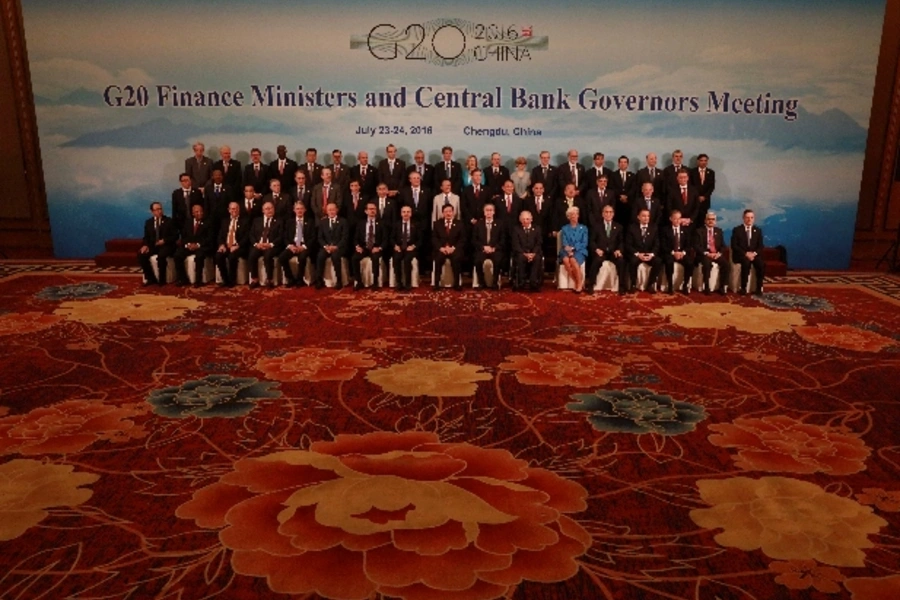Gabriel Walker is a research associate for Asia Studies at the Council on Foreign Relations. This is the second part of a series on China’s role in international development. Read the first part here.
One month from today, leaders and policymakers from the world’s largest economies will be rubbing shoulders in Hangzhou for the eleventh annual Group of Twenty (G20) summit. For China, which presides over the group in 2016, the event is the culmination of nine months of diplomatic hard work to realize broad goals like “breaking a new path for growth” and fostering “inclusive and interconnected development.”
More on:
One important development innovation that China has brought to this year’s proceedings is promoting the concept of “green finance.” Throughout the past year, China has spearheaded the meetings of the newly created “G20 Green Finance Study Group,” whose final report the G20 finance ministers and central bank governors officially welcomed into their agenda last month. One aspect of green financing in particular—fostering the nascent “green bond” market—offers China an important opportunity to display international leadership while contributing to global sustainable development.
Green bonds are debt securities whose proceeds fund projects with environmental benefits. Eligible initiatives include anything from energy-efficient buildings and pollution remediation to consumer loans for clean vehicles and renewable energy infrastructure. Multilateral development banks first issued green bonds in 2007 to satisfy investors’ growing appetite for globally conscious financial products. Since then, the issuance of green bonds has grown from just $807 million to $36.6 billion. By 2020, the value of global green bonds could be as high as $1 trillion, nearly a third of which could come from China.
Chinese institutions have shown a sustained interest in becoming world leaders in the green bond market. Just over a year ago, wind energy firm Xinjiang Goldwind issued China’s first green bond of $300 million—attracting sixty-seven investors who oversubscribed the bond by nearly five times. In late 2015, the People’s Bank of China (PBOC) and National Development and Reform Commission each issued their own guidelines on green bonds, establishing a relatively unified concept of how the bonds should be used to maintain environmental standards. In March 2016, China’s 13th Five-Year Plan specifically mentioned “developing green credit and bonds” as a top priority within its overall agenda for environmentally conscious industrial development. Soon after, the Shanghai Stock Exchange launched a green bond pilot initiative that requires issuers to follow specific certification, reporting, and accounting guidelines. In total, Chinese green bonds issued in the first half of 2016 amounted to 75 billion RMB ($11 billion), making China the largest market for green bonds anywhere in the world.
China’s ambition for green bonds stems largely out of necessity. Ma Jun, chief economist of the PBOC’s research bureau (not to be confused with Ma Jun the environmentalist), has estimated that China needs at least $320 billion of additional capital every year to clean up domestic pollution and fund green development projects. Currently, the Chinese government is only able to meet 15 percent of that demand. Furthermore, Ma has stated that using green financing for Belt and Road projects is in the long-term interests of Chinese investment institutions. However, China is not only embracing green finance for its own purposes—it is leveraging its G20 leadership to encourage other countries to follow suit. Chinese policymakers are in a good position to further clarify and cohere the green bond market, and doing so would show leadership and bring about tangible development benefits within and outside of China.
Chinese institutions can effectively formalize the international green bond market by:
More on:
- Clarifying what kinds of projects will be funded. Currently, Chinese standards allow green bond proceeds to fund clean coal projects. But should a coal-fired power plant, for example, especially one that uses relatively dirty, subcritical technology, really qualify as “green”? Chinese policymakers must either convince other stakeholders that fossil fuel–based projects are necessary for developing countries, and can be carried out with minimal environmental impact, or abandon the allowance altogether. China’s two sets of standards also differ over whether green bond revenues should fund nuclear energy projects.
- Determining how proceeds will be allocated. Chinese and international guidelines agree that green bond proceeds must be either earmarked or “ring-fenced” (deposited in their own account) to ensure they are used properly. However, guidelines differ in their transparency requirements for how unallocated funds are invested. Transparency is not a hallmark of Chinese financial institutions and corporations, so Chinese issuers must go above and beyond to maintain high standards for disclosure set forth by any international consensus on fund allocation.
- Standardizing the environmental reporting process. External reviews are crucial in maintaining the trustworthiness and reliability of green bonds for investors. Chinese and international standards encourage these reviews, but do not necessarily require them. Wholly independent and rigorous third-party “greenness” verification is essential for developing the green bond market, and Chinese policymakers should require it as the international gold standard.
September’s G20 summit is a meaningful moment for Chinese leadership on the world stage, and could also mark an important occasion for clarifying international norms of green finance. Over the past year, the Chinese government, financial institutions, and corporations have already shown their enthusiasm for green bonds. At the summit, Chinese leaders have a new opportunity to further define rules of the road for green bond project selection, proceeds allocation, and environmental reporting. Doing so would not only illustrate that China can deliver real results when leading a prominent multilateral forum, but also set the stage to mobilize vast resources for sustainable investments around the world.
 Online Store
Online Store
